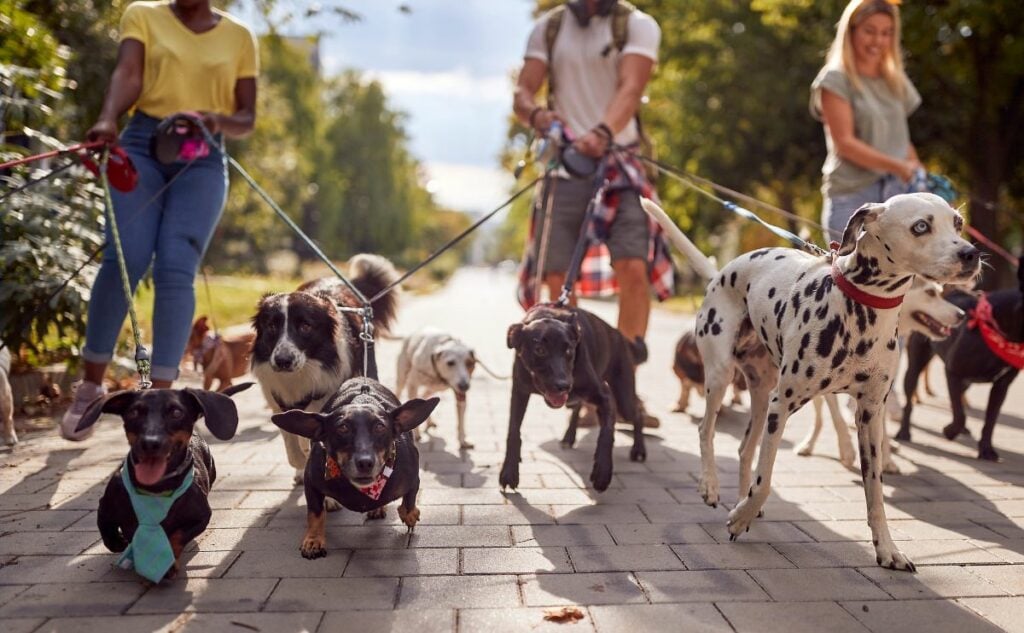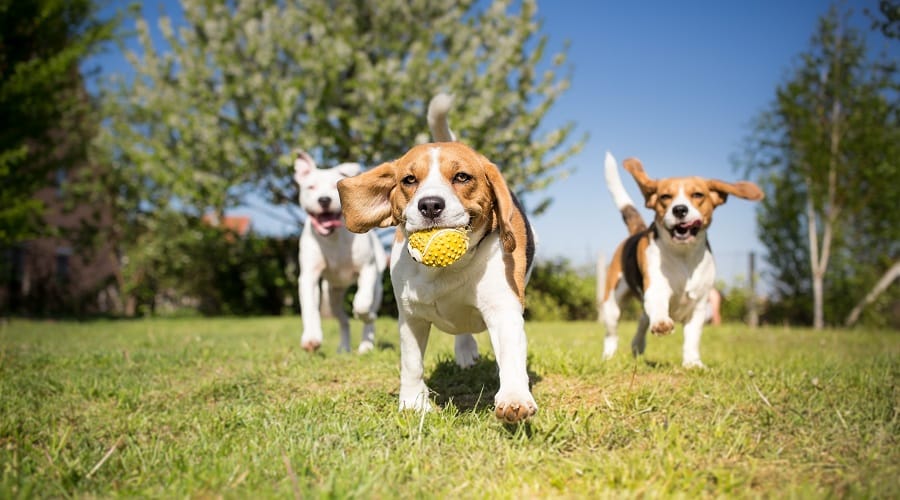How Many Dogs Is Too Many? Here’s Where To Draw The Line
When you purchase through links on our site, we may earn a commission. Here’s how it works.
You’ve probably asked yourself, “How many dogs are too many?” right after adopting your second (or fifth) furry friend. It turns out there’s a line between building a dream dog pack and biting off more than you can chew.
Table of Contents
Let’s break it down so you can figure out if you’re managing a happy home or secretly running a doggy daycare. This guide also helps you determine if your home is built for more paws… or if it’s time to hit paws on adopting again.

How Many Dogs Is Too Many?
Is three dogs too many? You’re not alone in wondering this. But when the leashes start piling up and your vacuum starts crying, the question gets real: How many dogs are too many?
The answer isn’t just a number. It depends on:
- Your lifestyle and daily schedule
- Your home size and setup
- Your ability to meet each dog’s emotional, medical, and behavioral needs
- Local laws and Homeowners Association (HOA) or landlord rules
- How well your current pets coexist
According to the World Animal Foundation, 49.5% of U.S. households own at least one dog, so you’ll be in good company. And the average is 1.46 dogs per household. People living in urban areas of the northeastern states tend to have fewer dogs than those who live in the mid-west, where the population is sparser and more outside space is the norm.
Expert tip: Most pet professionals agree that 1–2 dogs are manageable for the average household. More than 3 requires space, time, structure, and serious commitment.
So, if you’re already feeling stretched, overwhelmed, or low on time, even one more dog could tip the balance from joyful to stressful.
The Quick Pack Check: Can You Handle More Dogs?
Before you add another wagging tail to your home, ask yourself these five honest questions. Think of it as your pre-adoption gut check.

1. Do you have at least 2–3 hours a day to dedicate to your dogs?
That includes walking, playing, feeding, grooming, cleaning, and just being present. Dogs aren’t furniture. They need time and attention, not just food.
2. Can you comfortably afford vet visits, food, grooming, and emergencies for each dog?
Expect to spend around $2,000+ per dog per year. Multiply that by the number of paws in your house. If the math makes your stomach drop, pause here.
3. Is your home and yard spacious enough for more dogs?
A fenced yard isn’t a must, but it helps. Apartments or shared walls? That adds complexity, especially with energetic or vocal breeds.
4. Are your current dogs well-socialized and stable?
If there’s already drama over toys, food, or attention, another pup could make things worse. Pack dynamics can get complicated fast.
5. Are you doing this for the right reasons?
Loneliness, guilt, or social media pressure aren’t good reasons to adopt another dog. Make sure it’s a sustainable, thoughtful choice and not just a feel-good impulse.
Score 4 or 5 yes answers? You might be ready to grow the pack.
Score 3 or fewer? No shame, your current crew is lucky to have you as is. Remember, quality over quantity is always best.
So, before you fall in love with another set of puppy-dog eyes or wonder, “Is four dogs too many?” run through this sanity-saving checklist.
Legal Limits: How Many Dogs Can You Own In Your Area?
Spoiler: It’s not just up to you.
Many cities, counties, and even HOAs have rules about how many dogs you’re legally allowed to keep. These laws exist to protect animals, neighbors, and your sanity, even if you feel like you could handle a dozen doodles.
Here’s what to check:
- City & County Laws. Some areas cap dog ownership at 2–4 pets per household. In others, you’ll need a kennel license to have more.
- HOA or Rental Agreements. Your lease or HOA rules may limit pets or restrict certain breeds entirely.
- Zoning Restrictions. Rural areas are often more lenient, while urban zones are stricter due to noise, space, and density.
- Dog Parks & Boarding Facilities. Some limit how many dogs one person can bring in at a time. Plus, multiple dogs mean bigger boarding bills.
Pro Tip: Search “[Your City] + pet ownership laws” or call your local animal control office. It’s the quickest way to avoid fines or, worse, having to give up a pet.
Even if you’re emotionally ready for a pack, the law might say, “Not so fast.”
Dog Hoarding vs. Responsible Multi-Dog Ownership
There’s a big difference between being a devoted dog lover and becoming a dog hoarder. But the line can sneak up on you if you’re not paying attention.
Responsible Owners:
- Provide each dog with medical care, attention, and personal space
- Have the time and resources to meet every dog’s physical and emotional needs
- Keep their home safe, clean, and livable for both humans and animals
- Know when to say “no,” even if their heart says “yes”

Dog Hoarders (Often Unintentionally):
Now, some people take dog ownership a step too far, taking on scores of dogs that run wild around the home. They often:
- Accumulate more dogs than they can realistically care for
- Struggle to provide food, grooming, or vet care for all animals
- Live in cramped or unsanitary conditions
- Often believe they’re “rescuing” or “helping,” even when harm is happening
Also, most often, they are not de-sexed, leading to litters of unwanted puppies being born and a population explosion that continues unchecked. Such hoarding often leads to the authorities becoming involved and seizing all or some of the dogs for the animals’ welfare.
Dog hoarding is recognized as a mental health issue and animal welfare crisis. If you ever feel overwhelmed, you’re not alone. Help is available from local shelters and rescue organizations.
Dog Hoarding: Real Cases That Made Headlines
One real-life case in Pennsylvania involved almost 200 dogs living on one property. While the owners claimed to love them, many lived in unhealthy conditions. Over 30 had died, their bodies stored in freezers because the owners couldn’t let go.
Bottom line: Loving dogs doesn’t mean collecting them. It means knowing your limit and giving each pup the life they deserve.
Financial Reality Check: The True Cost Of Owning Multiple Dogs
Love is free. Dog food, vet bills, and poop bags? Not so much.
Average Yearly Cost Per Dog
Before adding to your furry squad, consider what each pup can cost because those expenses multiply fast. This is just a quick breakdown of what a dog can cost per year.

- Food & treats: $300–$600
- Routine vet care: $300–$700
- Grooming: $200–$500 (or more if they’re fluffy divas)
- Flea/tick/heartworm prevention: $100–$250
- Pet insurance: $300+ annually
- Toys, leashes, crates, and chaos control: $100+
According to the American Kennel Club (AKC), annual costs average around $2,500 for a dog’s food, grooming, vet checkups, pet-sitting fees, etc.
Now multiply that by 2, 3, or 4. Still feeling ready for more dogs? So, if you’re already stretching to care for one dog, more might break the budget and your sanity.
How Pet Insurance Can Help
If you’ve ever had a surprise vet bill knock the wind out of you, you’re not alone. From broken bones to mystery illnesses, dog emergencies happen fast and are often expensive.
That’s where pet insurance comes in. Think of it as a safety net that helps contribute towards unexpected costs like surgeries, diagnostics, and emergencies.
Did you know you can get pet insurance for more than one pet? Whether you’ve got pooches, cats, or a mix of both, many pet insurance providers offer multi-pet coverage, often with a built-in discount.
But with so many options out there, how do you know which offers the best value for your pack? We’ve chosen the best pet insurance plans for multiple pets based on coverage, price, and multi-pet discounts.
Pack Dynamics: How Dogs Establish Hierarchies At Home
Dogs are social animals, but that doesn’t mean they automatically get along like old friends at a reunion. In multi-dog homes, hierarchies form naturally. But sometimes, the drama does, too.
Common Pack Behaviors
- Posturing: Look at their body language, such as raised tails, stares, and stiff walks. This might mean, “I’m the boss now.”
- Resource guarding: Growling over toys, food bowls, or you
- Testing limits: Puppies especially love to push the pack pecking order
- Redirected aggression: One dog’s tension can cause a ripple effect
It’s not all bad, and many packs live in harmony. But more Fidos mean more potential for tension, especially when:
- You introduce a pooch with a dominant personality
- You don’t reinforce a calm, consistent structure
- Existing dogs feel jealous or territorial
Veterinary behaviorists say the key to peaceful pack life is supervision, space, structure, and early intervention when tension shows up.
When To Get Help
- If fights break out regularly
- If one dog starts bullying or isolating another
- If growling turns into biting or bloodshed
In those cases, consult a dog behaviorist ASAP. Sometimes, rehoming is the kindest, safest choice for the entire pack, including the humans.
Size & Breed Compatibility: What Works (& What Doesn’t)
It’s easy to fall in love with a dog based on looks or a cute adoption ad. But in a multi-pet home, size and temperament matter more than you think.
Why Size Compatibility Is Crucial
- A playful paw swipe from a Great Dane can accidentally hurt a Chihuahua
- Feeding time or roughhousing can turn dangerous if one massively outweighs the other
- Smaller pups may become anxious or reactive around bigger, bouncier breeds
Even if they’re friendly, mismatched sizes can create stress and sometimes injury. However, size differences might not make any difference in their blossoming friendship. Every dog is different.
Breed Energy & Personality Types
Dogs bred for different jobs bring different personalities to the pack. Matching energy levels and confidence levels, not just size, makes for a smoother household. For example, avoid pairing a high-anxiety dog with a dominant one or a low-energy senior with a hyperactive puppy.
Overall, it’s essential to think beyond breed and size. You’re creating a team, not just collecting cuteness.
Best Dog Breeds For Multi-Dog Households
Some dogs are just built for teamwork. Whether they were bred to hunt in packs or just love constant companionship, these breeds tend to thrive in multi-dog homes.
So, if you already own one or two dogs and you’re looking to add another, or if you’re considering buying a dog that has a natural pack affinity, you might want to consider the following breeds.
Siberian Husky
Siberian Huskies are probably the best-known of the domestic pack breeds. Working Siberian Huskies live in packs and work together, too, hauling sleds across ice and snow. They crave social time and get bored (and destructive) when left alone.
The Husky is a very active breed that needs lots of exercise. These are also highly extroverted, social dogs that typically thrive in a multi-dog household where lots are going on to keep them interested.
Best for: Active owners with time to burn off daily zoomies.
Border Collie
Crazy smart, crazy fast, and crazy loyal, Border Collies love structured environments where they have both human direction and canine company. Collies are highly intelligent and super-active dogs that need lots of exercise and mental stimulation to keep them happy.
Although some Border Collies work alone in a sheep herding role, plenty of Collies work in groups of two or three. They can be aloof with outsiders but are very affectionate with their pack.
Best for: Owners committed to training and high-energy play.
Beagle
The Beagle was bred to hunt in packs and is naturally social. They’re happiest when surrounded by other dogs or at least not left home alone. In a working role, beagles live in large packs that are kept together in hunt kennels.
Thanks to their natural affinity with other dogs, Beagles are very sociable pets, enjoying the company of others both in a household and at the dog park. Beagles are busy, active little dogs that enjoy plenty of exercise.
Best for: Families with yards and kids who love active play.
English Foxhound
Foxhounds come from a similar background to Beagles. As their name suggests, these pups were used to working in packs, scenting and hunting foxes, while the hunters and supporters followed the pack on horseback.
Today, you’ll also find some Foxhounds living as pets in domestic households. The breed is not the easiest to train. But if you’re up for the challenge, you’ll find the foxhound to be a friendly, active dog that thrives in a mini-pack setting.
Best for: Households with space to roam and multiple dogs to romp with.
Alaskan Malamute
The Alaskan Malamute is similar in looks to the Siberian Husky, and he also has a comparable history. Like the Husky, the Malamute traditionally lived and worked in packs where he was used as a sled dog, hauling heavy loads of supplies across the harsh terrain of the far north.
Alaskan Malamutes kept as pets are highly social extroverts who love canine company and usually do well in a multi-dog setting. The Malamute is often everyone’s best friend in the dog park, too.
Best for: Cold climates, experienced dog owners, and big backyards.
Remember that although these breeds generally adapt better in groups, training, temperament, and the individual dog’s history matter just as much as genetics.
Breeds That Prefer Being The Only Pet
While some dogs love a crowd, others… not so much. Certain breeds were built to work alone, guard their territory, or bond deeply with a single human. They don’t always enjoy sharing space, toys, or your lap.
Common “Lone Wolf” Breeds
- American Pit Bull Terrier. Loyal and affectionate with humans, but can be reactive or territorial around other dogs without proper socialization.
- Kerry Blue Terrier. Bold and confident, but often dog-selective or aggressive toward unfamiliar pups.
- Akita. Independent, protective, and naturally reserved. They tend to do best as solo pets. Same-sex aggression, particularly between females, can unfold.
- Shiba Inu. Known for their aloof, cat-like nature.
- Chow Chow. Proud and stubborn. Often, they bond tightly to one person and may not tolerate other dogs.
What About Mixed Breeds?
If you’re thinking of rehoming a crossbreed pup from a shelter or rescue center, try to work out what breeds the mix is made up of. For many, their history and genetic makeup are unknown. Thankfully, dog DNA tests can help.
While it won’t tell you whether they’ll be a couch potato or chaos agent, it will reveal their breed makeup. This is a major clue when planning for pack compatibility, energy levels, and future needs
Responsible shelters also conduct tests to determine what pups get on well with others and which prefer their own company.
Good news: Many shelters offer “foster-to-adopt” programs so you can test compatibility before committing. Always ask about dog-dog interaction tests before bringing home a new friend.
So, How Much Is Too Much?
As dogs are pack animals, a family of one, two, or three dogs is thought to be better than one solitary animal that relies solely on you for company. However, the more dogs you own, the less individual attention each dog will receive from you. And that can be where problems begin.
Of course, if you have a large family, the human-to-dog attention ratio can be more balanced, with each family member having one or two “favorite” pups. It really all depends on your circumstances. Generally, most people can comfortably own one or two dogs, although that’s often a full-time job!

Some folk who maybe have a large family and live in a vast place with lots of indoor space and land outside may be able to balance four to six. However, owning more than six dogs takes an extraordinary person with exceptional devotion and the resources to go with it.
Is Owning More Than One Dog Right For You?
Before you rush out and take on an extra Fido or two, take stock of your situation. Owning one dog is a very rewarding and joyful experience. With the right forethought and care, owning two or three can be even more satisfying.
Our Personal Experience With Finding The Right Number Of Dogs
I’ve always had a soft spot for rescue animals, and I can never seem to resist a cute, furry face. That combination has filled my life with more pets than most people would believe.
For most of my adult life, I’ve had three dogs at a time. That number has always felt just right.
It meant there was always a dog nearby for anyone who needed a cuddle or a companion. It brought balance and joy to our home, even on the hard days.
Of course, having three dogs isn’t easy. It’s a lot of work, especially when they’re different sizes and breeds.
I once had a five-pound Chihuahua who insisted on walking next to her two 85-pound Labrador siblings. She couldn’t keep up for long, but she always gave it her best, full of heart and determination.
Between varying energy levels, separate feeding times, and special diets, it sometimes felt like I was running a canine B&B. But to me, it was home.
– Danielle DeGroot, Rescue Dog Mom & Canine Journal Writer
Frequently Asked Questions About Owning Multiple Dogs
Bringing more dogs into your home can be incredibly rewarding, but it also comes with new challenges, quirks, and “why didn’t anyone warn me?” moments.
Got a question I didn’t cover? Drop it in the comments. We’d love to hear what’s on your mind and may feature your question in a future update!
How Do I Introduce a New Dog to My Existing Pets?
Start on neutral ground, like a park, and keep both dogs on leashes. Let them sniff, walk together, and observe body language before bringing the new dog into your home. Always supervise early interactions and give each dog their own space and resources.
Does Age or Gender Matter When Adding Another Dog?
Yes. Pairing dogs with compatible energy levels, temperaments, and opposite sexes (especially if unneutered) can reduce conflict. A young, rowdy pup might overwhelm an older dog, while two dominant males may struggle to share space peacefully.
How Do I Train Multiple Dogs at Once Without Chaos?
Teach each dog basic commands individually before practicing as a group. Use name-based cues (e.g., “Max, sit”), reinforce calm behavior during group activities, and separate feeding times if needed. Consistency and structure are key.
Are There Signs I Might Have Taken on Too Many Dogs?
If you’re feeling overwhelmed, financially strained, or emotionally burnt out, or if your dogs show signs of stress, fighting, or neglect, those are red flags. Quality of care always matters more than quantity of pets.
How Do I Prevent Jealousy Between My Dogs?
Give equal attention, avoid favoritism, and reward calm behavior around each other. Separate high-value items (toys, bones, beds) to avoid tension, and always supervise new interactions until trust is built.
Keep Your Pack Happy, Healthy, & Thriving
Now that you’ve figured out your perfect pack size, don’t stop there. Give your pups the best life possible with a few simple upgrades.
Start by investing in high-quality dog food. Although it may cost more upfront, it supports better digestion, stronger immunity, and often fewer surprise vet bills in the long run.
Keep their minds sharp and their energy channeled with interactive dog toys, especially if you’ve got multiple pups vying for your attention.
Want to add more years to your dog’s life? Discover the daily habits and health hacks that lead to longer, happier lives.
And don’t skip those annual vet visits. They’re your best defense against costly emergencies and silent health issues.
We love to hear from our readers! Have you ever managed a multi-dog household, or are you considering adding another to your pack? Share your stories, tips, or questions in the comments below because we’re all ears (and wagging tails)!



